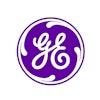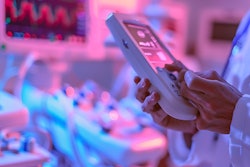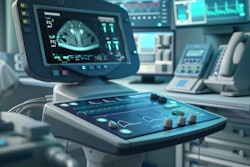Ultrasound's versatility, adaptability, and reliability will be evident at this year's ECR, underlining its added value in a great variety of clinical applications.
Research to be presented at the annual meeting in Vienna will investigate the modality's use in abdominal, genitourinary, musculoskeletal, women's imaging, and other areas. This includes recent advances in ultrasound, such as the use of contrast for improved imaging, elastography, and color Doppler for assessing complex pathologies and using imaging data in AI models.
Studies will also evaluate aspects such as attenuation and echogenicity, as well as the use of interferometry. Ultrasound's performance will be compared with CT and MRI in detecting pathologies, as well as for how ultrasonic measures validate treatment strategies such as radiotherapy in cancer treatment and surgery for musculoskeletal pathologies.
Additionally, ultrasound's use as a supplemental tool will be explored, including for breast cancer detection and follow-up imaging for assessing aneurysm risk. Research will show how using sonographic imaging data in machine learning can improve current risk assessment models, such as TI-RADS for thyroid nodule assessment and avoiding unnecessary biopsies.
Contrast-enhanced ultrasound (CEUS) will also be on display in Vienna. Researchers will demonstrate the promise of CEUS for assessing ablation treatment and evaluating cancers undergoing chemotherapy. Other presentations will compare the efficacy of multiple contrast agents in ultrasound and fusion imaging. AI studies will also show how using ultrasound features and parameters can lead to better diagnosis and assessment of suspicious findings. This includes using conventional ultrasound and elastography data to better inform radiologists for head and neck imaging.
Below is a selection of ECR 2024 scientific sessions that caught our attention.
Abdominal
In abdominal ultrasound, research presentations will focus on optimization of hepatic examinations, patient follow-up after interventional procedures, use of AI and machine learning, and other hot topics.
See below for our highlighted abdominal ultrasound presentations:
- Liver fibrosis and steatosis ultrasound screening: a FibroScan study. RPS 314: 28 February, 11:30-12:30 CET, ACV Room G1.
- Ultrasound-based steatosis grading system using 2D-attenuation imaging: an individual patient data meta-analysis with external validation. RPS 801: 29 February, 09:30-11:00 CET, ACV Research Stage 1.
- Comparison of findings on transabdominal ultrasound and magnetic resonance enterography with macroscopic changes on colonoscopy in patients with Crohn's disease. RPS 901: 29 February, 12:30-13:30 CET, ACV Research Stage 4.
- 3D fusion is superior to 2D point-to-point contrast-enhanced US to evaluate the ablative margin after radiofrequency ablation for hepatocellular carcinoma RPS 1009: 29 February, 14:00-15:30 CET, ACV Research Stage 4.
- Risk stratification of gallbladder masses by machine learning‑based ultrasound radiomics models: a prospective and multi‑institutional study. RPS 2401: 3 March, 11:30-12:30 CET, Research Stage 3.
Genitourinary
The best use of ultrasound imaging in prostate cancer patients will be a central theme at ECR 2024. Here is a selection of genitourinary research presentations:
- Sensing ultrasound localisation microscopy for the visualisation of glomeruli in living humans. RPS 407: 28 February, 13:00-14:30 CET, ACV Research Stage 3.
- Five-year outcomes after transurethral ultrasound ablation of localised prostate cancer. RPS 1507: 1 March, 14:00-15:30 CET, ACV Research Stage 3.
- A single-centre retrospective study of 300 men with localised primary prostate cancer treated using MRI-guided transurethral ultrasound ablation. RPS 1909: 2 March, 12:30-13:30 CET, ACV Research Stage 1.
- Ultrasound/ MRI fusion-guided transperineal laser ablation in the treatment of localised radiotherapy-resistant prostate cancer. RPS 2007: 2 March, 14:00-15:30 CET, ACV Research Stage 4.
Musculoskeletal (MSK)
In MSK ultrasound, research presentations will focus on the utility of high-resolution ultrasound as well as developments in shear-wave elastography and with ultrasound-guided injections.
See below for our highlighted MSK ultrasound presentations:
- UItrasound-guided five percent dextrose and corticosteroid injections in patients with carpal tunnel syndrome: one-year follow-up. RPS 510: 28 February, 15:00-16:00 CET, ACV Research Stage 3.
- Shear-wave elastography for the evaluation of tendinopathies: a systematic review and meta-analysis. RPS 710, 29 February, 08:00-09:00 CET, ACV Research Stage 3.
- Ultrasound-guided percutaneous irrigation of extra-shoulder calcific tendinopathy. RPS 910: 29 February, 12:15-13:45 CET, ACV Research Stage 3.
- High-resolution ultrasound of the anterior talofibular ligament: correlation between morphological and clinical features. RPS 910: 29 February, 12:15-13:45 CET, ACV Research Stage 3.
- Shear-wave of patellar and Achilles tendon on healthy patients: intervendor, intraobserver, and interobserver comparison. RPS 910: 29 February, 12:15-13:45 CET, ACV Research Stage 3.
Women's imaging
Breast ultrasound is always a popular topic at ECR, as is fetal ultrasound. These research presentations captured our interest:
- Ultrasound guided vacuum-assisted biopsy to assess pathological complete response to neoadjuvant therapy: a paradigm shift in breast cancer treatment. RPS 602: 28 February, 16:30-17:30 CET, ACV Research Stage 1.
- Added detection potential of ultrasound in the diagnostic assessment of breast cancer: an Italian longitudinal multicentric study. RPS 1002: 29 February, 14:00-15:30 CET, ACV Research Stage 3.
- Role of shear wave elastography in prediction of preterm labour. RPS 1107: 29 February, 16:00-17:30 CET, ACV Research Stage 4.
- Myocardial strain assessment in the human foetus by cardiac MRI using Doppler ultrasound gating and feature tracking. RPS 1912: 2 March, 12:30-13:30 CET, ACV Research Stage 4.
- The ICE Study: to detect cryoimmunologic response induced by ultrasound-guided cryoablation on early breast cancer: preliminary results. RPS 2002: 2 March, 14:00-15:30 CET, ACV Research Stage 2.
Ultrasound technology trends
By Mustafa Hassan, PhD, Signify Research
At ECR 2024, ultrasound vendors will be looking to showcase the newest tools in their arsenal in the ongoing competitive market merry-go-round. We expect to see the following:
- Siemens showcasing its platform of solutions, including its new Acuson Maple system. It could also include its new premium cardiovascular system, the Acuson Origin
- Esaote's new ultrasound systems – the MyLab A50 and MyLab A70
- Philips could exhibit its recently FDA-approved X11-4t Mini 3D TEE transducer, which is also currently pending CE Mark
- Mindray will showcase its TE Air handheld ultrasound device, which it recently launched as a solo device
- GE Healthcare will demonstrate its integration of Caption Guidance, from its acquisition of Caption Health, into its Venue product line
- Samsung will highlight its new V6 system and new AI solutions such as HeartAssist
- Canon Medical, in response to the growing need for a bridge between clinical excellence and education, will focus on education with a dedicated educational area named Canon Medical Academy Europe
These announcements show that vendors are looking to be more comprehensive with their ultrasound portfolios and offering a range of ultrasound systems at different price points. With customers switching vendors based purely on price, especially in radiology, offering systems that can cater to all budgets will help ensure vendors do not lose customers. The developments also show that vendors are looking to add more software features, such as AI and educational platforms.
AI has long been a key topic at trade shows and with the focus of ECR 2024. While there may not be as many ultrasound AI vendors exhibiting compared to previous shows, they will be present and looking to strike partnership deals, to help bring their product to market. In our recently published Ultrasound AI 2023 report, we highlighted the increased collaboration between AI vendors and ultrasound original equipment manufacturers (OEMs) as a key market trend, which we have seen continue into 2024 and expect to also be a key trend at ECR.
The figure below pinpoints new ultrasound AI partnerships/acquisitions since May 2022.
| Clinical Application |
ISV |
Partner |
Deal Type |
|---|---|---|---|
| Breast |
Koios Medical |
Sirona Medical |
Partnership |
| Cardiology |
Caption Health |
GE HealthCare |
Acquisition |
| Cardiology |
DiA Imaging Analysis |
Philips |
Acquisition |
| Cardiology |
Ligence |
Blackford Analysis |
Partnership |
| Cardiology |
UltraSight |
EchoNous |
Partnership |
| Cardiology |
Us2.ai |
Aidoc |
Partnership |
| Cardiology |
Us2.ai |
Viz.ai |
Partnership |
| Cardiology |
Ventripoint Diagnostics |
ASCEND Cardiovascular |
Partnership |
| Thyroid |
Medo.ai |
Exo |
Acquisition |
While AI is being embraced more by ultrasound users, it is mainly for workflow automation tools. We are seeing more ultrasound OEMs introducing AI into their systems. In addition to this, with supply chain issues now mostly under control, vendors will now be looking to demonstrate their ability to meet the demand for orders. Amid the uncertain global financial climate, they will also aim to be as flexible as possible with their customers' varying budgets.




